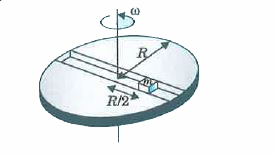A frame of reference that is accelerated with respect to an inertial frame of reference is called a non-inertial frame of reference. A coordinate system fixed on a circular disc rotating about a fixed axis with a constant angular velocity ω is an example of non=inertial frame of reference. The relationship between the force →Frot experienced by a particle of mass m moving on the rotating disc and the force →F∈ experienced by the particle in an inertial frame of reference is
→Frot=→Fin+2m(→vrot×→ω)+m(→ω×→r)×→ω.
where →vrot is the velocity of the particle in the rotating frame of reference and →r is the position vector of the particle with respect to the centre of the disc.
Now consider a smooth slot along a diameter fo a disc of radius R rotating counter-clockwise with a constant angular speed ω about its vertical axis through its center. We assign a coordinate system with the origin at the center of the disc, the x-axis along the slot, the y-axis perpendicular to the slot and the z-axis along the rotation axis (→ω=ωˆk). A small block of mass m is gently placed in the slot at →r(R/2)ˆi at t=0 and is constrained to move only along the slot.

The distance r of the block at time is
A
R4(e2ωt+e−2ωt)
B
R4(eωt+e−ωt)
C
R2cos2ωt
D
R2cosωt
Video Solution
Text Solution
The correct Answer is:B
It is given that X-axis is along the groove and Y-axis is perpendicular to the groove. Z-axis is perpendicular to the plane of the disc.
Above described frame is assumed to be fixed with the axis hence it rotates along with mg the disc. We can understand that in this rotating frame of reference particle is moving along X-axis only. Hence position vector, velocity vector and acceleration vector are directed along the X-axis only.
→r=rˆi,→vrot=(dr/dt)ˆi,→ω=ω→kand→Frot=m(d92)r)dt2ˆiN1,N2 and mg shown in figure are real forces which act in inertial frame. Hence we can write the following:
→FinN1ˆj+(N2−mg)ˆk ...(i)
Force acting on the particle with respect to rotating frame of reference is given as follows:
→Frot=→Fin+2m(→rrot×→ω)+m(→ω×→r)×→ω ...(ii)
Substituting all values in equation (ii) we get the following:
md2rdt2ˆi[N1ˆj+(N2−mg)ˆk]+2m(drdtˆi×ωˆk)+m(ωˆk×rˆi)×ωˆk
⇒md2rdt2ˆi=mω2rˆi+(N1−2mωdrdt)ˆj+(N2−mg)ˆk
On comparing the individual components on both the sides of the equation we get
d2rdt2=ω2r ...(iii)
N1=2mωdrdt ...(iv)
N2=mg ...(v)
We can see that value ofr given in option (b) satisfies our equation (iv) and also it satisfies the boundary condition of t=0, R/2. Hence option (b) is correct.

|
Topper's Solved these Questions
- SYSTEMS OF PARTICLES AND ROTATIONAL MOTIONBOOK - MODERN PUBLICATIONCHAPTER - SYSTEMS OF PARTICLES AND ROTATIONAL MOTIONEXERCISE - COMPETITION FILE (OBJECTIVE TYPE QUESTIONS (ASSERTION REASON TYPE QUESTIONS) )
10 Videos
- SYSTEMS OF PARTICLES AND ROTATIONAL MOTIONBOOK - MODERN PUBLICATIONCHAPTER - SYSTEMS OF PARTICLES AND ROTATIONAL MOTIONEXERCISE - COMPETITION FILE ( OBJECTIVE TYPE QUESTIONS (MATCHING TYPE QUESTIONS) )
3 Videos
- SYSTEMS OF PARTICLES AND ROTATIONAL MOTIONBOOK - MODERN PUBLICATIONCHAPTER - SYSTEMS OF PARTICLES AND ROTATIONAL MOTIONEXERCISE - COMPETITION FILE ( OBJECTIVE TYPE QUESTIONS (JEE (Main) & Other State Boards for Engineering Entrance) )
48 Videos
- PHYSICAL WORLD BOOK - MODERN PUBLICATIONCHAPTER - PHYSICAL WORLD EXERCISE - Revision exercises (Long answer questions)
6 Videos
- THERMAL PROPERTIES OF MATTERBOOK - MODERN PUBLICATIONCHAPTER - THERMAL PROPERTIES OF MATTEREXERCISE - CHAPTER PRACTICE TEST
15 Videos
Similar Questions
Knowledge Check
A frame of reference that is accelerated with respect to an inertial frame of reference is called a non-inertial frame of reference. A coordinate system fixed on a circular disc rotating about a fixed axis with a constant angular velocity ω is an example of non=inertial frame of reference. The relationship between the force →Frot experienced by a particle of mass m moving on the rotating disc and the force →F∈ experienced by the particle in an inertial frame of reference is
→Frot=→Fin+2m(→vrot×→ω)+m(→ω×→r)×→ω.
where →vrot is the velocity of the particle in the rotating frame of reference and →r is the position vector of the particle with respect to the centre of the disc.
Now consider a smooth slot along a diameter fo a disc of radius R rotating counter-clockwise with a constant angular speed ω about its vertical axis through its center. We assign a coordinate system with the origin at the center of the disc, the x-axis along the slot, the y-axis perpendicular to the slot and the z-axis along the rotation axis (→ω=ωˆk). A small block of mass m is gently placed in the slot at →r(R/2)ˆi at t=0 and is constrained to move only along the slot.

The net reaction of the disc on the block isA(a) 12mω2R(e2ωt−e−2ωt)ˆj+mgˆkB(b) 12mω2R(eωt−e−ωt)ˆj+mgˆkC(c) −mω2Rcosωtˆj−mgˆkD(d) mω2Rsinωˆj−mgˆkNon-inertial frame of reference have
Azero acceleration.Bsome acceleration with respect to inertial frame of reference.Czero velocity.Dconstant velocity with respect to inertial frame of reference.An inertial frame of reference is, by definition,
Aa frame moving with uniform velocity w.r.t. earthBa frame moving with velocity w.r.t our SunCa frame which is not rotatingDa frame in which Newton's first law of motion is valid.
